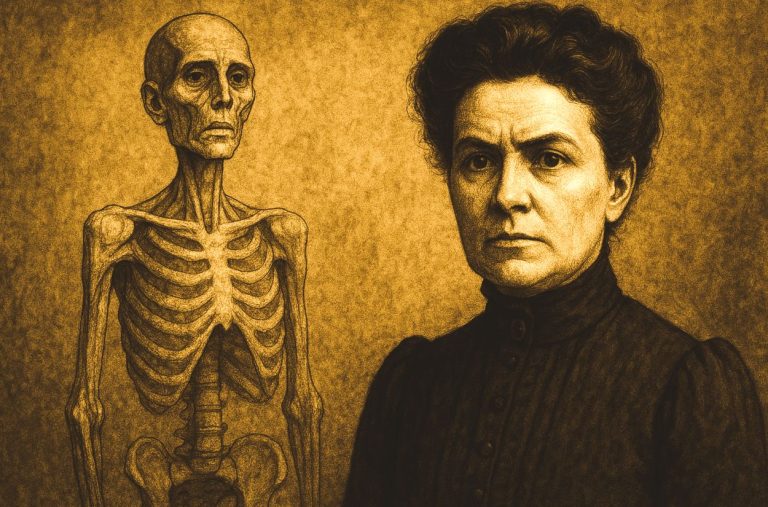

At the federal level, some infectious disease experts suggested there were other, larger challenges afoot, such as the purge of vaccine advisers.

By Peter Andrey Smith
Reporter and Researcher
Most antibiotics come from soil, and the one that Gerry Wright’s research team recently discovered in Hamilton, Ontario was no exception. The lasso-shaped string of molecules came from a microbe living in the garden soil of one of Wright’s lab technicians. Its name: lariocidin.
Wright, a chemical biologist at McMaster University, has for decades made concerted efforts to collect soil, often on a shoestring. Despite his standing — he is a well-known figure in the field of antibiotic discovery — funding is scarce. “You cannot write a grant that says, ‘I’m going to go and collect a bunch of environmental samples, and then something good might come of it,’” he said. “You just can’t.” One time, a student’s father, who worked for the Bank of Montreal, which has locations in every hamlet in Canada, sent out a nationwide request, and account holders mailed him small bags of soil. But the effort to find new antibiotics, like lariocidin, required larger quantities, hence the backyard excavation.
Turning a discovery like lariocidin into a drug stocked at pharmacy counters usually takes millions of dollars. For this particular antibiotic, even the first step — coaxing something new out of the soil — took over a year. It involved a novel method of essentially starving the microbes of nutrients, then growing them in Petri dishes.
The next step involved characterizing its chemistry, For lariocidin, the funding to do that work leveraged a portion of hundreds of thousands of dollars in National Institutes of Health funding that went to Wright’s collaborators at the Department of Pharmaceutical Sciences at the University of Illinois, Chicago. (Wright had planned on applying for additional NIH funding to improve the compound’s antibiotic properties.)
When the discovery of the new antibiotic was announced in the journal Nature in March, it represented a major break: Lariocidin represented a whole new class of antibiotics that works differently than other previously discovered drugs, which may help treat drug-resistant infections. In the spring of 2025, Wright remained optimistic about lariocidin’s development and expressed high hopes of a continued cross-border collaboration.
Then came the funding cuts.
In May, U.S. officials terminated all NIH applications for grants with foreign subawards — the type of grant that applies to Wright’s work. The agency previously approved some 3,600 grants that awarded about $400 million to support researchers working at institutions outside the U.S. in fiscal year 2024. But now, as a Canadian researcher, Wright told Undark, his involvement in any U.S. grants to turn lariocidin into a viable drug are now a no-go.
His situation is perhaps reflective of broader trends in antibiotic research, and it may be poised to get worse. Earlier this year, 41 organizations pressed federal officials on the status of a meeting of the President’s Advisory Council on Combating Antibiotic Resistant Bacteria, which, so far, hasn’t happened. The Trump administration proposed $18 billion in cuts to the NIH. The primary agency funding antibiotic research and development, the National Institute of Allergy and Infectious Diseases — one of 27 institutes and centers that make up the NIH — showed the single largest dollar amount of terminated grants. The NIH budget would be slashed by more than 40 percent.
NIAID did not respond to multiple requests for comment regarding exactly how much those funding cuts will affect antibiotic research. (Its public budget states the agency supports “critical long-range priorities with funds carefully aligned to key research on infectious diseases,” including antibiotic resistance.)
Still, the recent cuts affect nearly all areas of science, and any uncertainty surrounding government funding for antibiotics stands in marked contrast to history and the field’s continued reliance on federal money. Eighty years ago, a massive influx of U.S. government funding underwrote the production of penicillin, the first commercially available antibiotic drug derived from natural sources.
Several experts told Undark that federal funds play a critical role in antibiotic discovery. One reason: The drugs are not typically profitable — in part because most people only need them for a short period of time. Because antibiotics don’t make much money, the pharmaceutical industry focuses research and development on more profitable drugs to treat chronic diseases. Mark Blaskovich, a member of the Center for Superbug Solutions at the University of Queensland, Australia, is among those who saw all of that dramatically diminishing. “With cuts to NIH overall, there will be a disproportionate effect on research into antibiotics compared to other drug classes, just because that field is so dependent on government funding,” Blaskovich told Undark.
And when the well runs dry, people die. Without effective antibiotics, Blaskovich said, common surgical procedures like hip replacements and C-sections will be much more dangerous: “They all become untenable because the risk of infection is so high.” Before the discovery of antibiotics, Blaskovich added, “40 percent of people ended up dying from infections.”
Ten days after the bombing of Pearl Harbor, on Dec. 17, 1941, a committee overseen by Vannevar Bush, then head of the Office of Scientific Research and Development, convened a meeting at the University Club in New York to spur the industrial-scale production of commercial antibiotics. It would be one of the first times government officials met with executives from major players in the pharmaceutical industry, including Merck, Squibb, Pfizer, and Lederle. As Pfizer’s president at the time reportedly put it, the penicillium mold, the basis for the drug, was “as temperamental as an opera singer.” Industry leaders seemed to think scaling up penicillin production was a waste of time. The outlook was dismal.
But, under Bush, the U.S. federal government persisted, bankrolling the penicillin project, a top priority just behind the Manhattan Project to develop the atomic bomb. The strain of penicillin that would go on to mass produce the drug, NRRL 1951, came from a government lab in Illinois. By some accounts, commercial firms overspent and overbuilt, prompting at least one critic to wonder “whether they have heard a war is being fought.” But the project undeniably laid a foundation for the modern pharmaceutical industry. “And that became an important exemplar for governmental funding of science,” wrote Scott Podolsky, the author of “The Antibiotic Era,” in an email to Undark, adding that the project manifested in the golden era expansion of the NIH.
The times have since changed. Michael Baym, at Harvard Medical School, who studies antibiotic resistance, said his lab had five federal grants terminated earlier this year, as a result of the Trump administration’s ongoing standoff with the university. He compared what’s happening — the scale of cuts to basic research on evolutionary biology to payments for janitorial services — to “a natural disaster.” Baym argued the federal grants should not be thought of as gifts from the government to wealthy, elite institutions. “I think of university research as almost like a distributed national lab system,” Baym said. “This is the system laid out by Vannevar Bush three quarters of a century ago.”
Seen this way, the wholesale defunding of the U.S. scientific infrastructure affects many areas of research, some more than others. As Blaskovich put it: “Even if cuts are applied evenly across all the programs, they’re going to have a much greater impact on reducing the ability to do antibiotic research, which we desperately need.” Federal officials have targeted infectious diseases, for instance, citing unfounded claims to undermine vaccine research or invoking allegations that a lab leak spawned the Covid-19 pandemic as justification to halt research. Antibiotics did not seem to be explicitly targeted, but rather collateral damage for anti-scientific ideologies. “It seems like they are looking for every excuse to deny science funding,” Baym said.
This has highlighted another undeniable fact: the reliance on public funding. (NIH contributed to all but two of the 356 drugs approved between 2010 to 2019, excluding antibiotics and other antimicrobials.) In recent years, all but very few major companies had largely given up on antibiotic discovery. “Large pharmaceutical companies have abandoned antibiotic research, not just because it is extremely challenging, but because it cannot be justified economically,” Blaskovich and a co-author wrote in a 2025 review. “The direct net present value of an antibiotic is close to zero.” Another 2023 article from the journal Clinical Infectious Diseases made a similar point: “The lack of investment in antibacterial development from large pharmaceutical companies leaves a significant void that requires federally supported intervention.”
Experts say that the need for this support stems from a stark financial reality: An antibiotic that proves curative has little market value. Unlike drugs for chronic diseases, which people take — and pay for — long term, when antibiotics are effective and work as intended, the drugs provide a cure. (That is, the drug clears the acute infection it’s been prescribed to treat.) The current model for antibiotics means any newly approved drug is often used as a last resort. Since the newer drugs are more expensive than older ones, insurance companies don’t always approve them as a first option; new antibiotics are typically classified as “reserve” to help combat antibiotic resistance. The situation, as Michael Osterholm, director of the Center for Infectious Disease Research and Policy at the University of Minnesota, put it at a meeting nearly a decade ago, is sort of like a salesman who sells a car and then explains that it can only be driven on Sundays between 8 a.m. and 10 a.m.
In recent years, an alphabet soup of nonprofits and initiatives, with acronyms such as ND4BB, JPIAMR, and CARB-X emerged to address the problems. The EU poured billions into funding. For-profit startups stepped into the space. But, Baym said, that does not necessarily obviate the need for public investment: With antibiotics, “it’s one of the very clear examples of a place of research that clearly benefits humanity as a whole.”
The basic research and collaboration that has historically gone into making these life-saving therapeutics seemed emblematic of the kind of science that didn’t have a specific financial interest. “No one has a personal incentive to develop new antibiotics, but everyone has a benefit from them existing,” Baym said. “Not to get too philosophical, but this is why we form governments — to make decisions that are in everyone’s good, even if they are not in any individual’s, like, this is literally the role of government.”
The search for solutions continues in earnest. In June of 2025, in Boston’s Seaport District, inside a massive 500,000-square-foot conference center, BIO, one of the world’s largest biotechnology and life sciences conferences, drew thousands of attendees. Squirreled away in a small meeting room on the second floor, about 80 people gathered to hear a panel discussion about antibiotics. It was hardly the headline event. But the mood seemed both urgent and dour. The moderator, Steve St. Onge, an executive with Clarametyx Biosciences, a private biotechnology company involved in later stages of drug development, such as the work leading up to clinical trials, began by reiterating that antimicrobial resistance remains one of “the most pressing global challenges.”
“Without reshaping our current thinking, we’re at risk of returning to the pre-antibiotic era. And I don’t say that lightly,” he said. “This has an impact on things that we take for granted in everyday modern medicine: elective surgeries, patients that are receiving chemotherapies, patients that are receiving organ transplant, and I think the list goes on.”
The panelists spoke about the challenges: One described how surgeons routinely replace patients’ surgically-implanted heart valves rather than trying to treat back bacterial infections caused by biofilms — a problem that extends to other implantable devices. Others spoke about the lack of financial opportunity and the field’s subsequent brain drain. One company successfully developed, tested, and trialed a new antibiotic only to have their estimated worth crater upon the drug’s approval. (Data suggest, according to one 2024 review paper in Nature Medicine, “Of the last ten antibiotics reaching market, seven of the companies that launched them have either gone bankrupt or succumbed to a distressed sale.”) Another mentioned how insurers made patients take low-cost but ineffective medications before getting effective antibiotics, meaning they got worse before getting better.
There was no mention of federal funding cuts. Perhaps the situation seemed dire enough already. At the federal level, some infectious disease experts suggested there were other, larger challenges afoot, such as the purge of vaccine advisers, like the Centers for Disease Control and Prevention’s Advisory Committee on Immunization Practices. Many funding issues predated the current administration, and, while important, these challenges tended to fly under the radar. One BIO panelist, Maud Eijkenboom, the managing director of Lixa, an Australian biotechnology company, suggested that the problems are large enough that solutions will get funded. Erin Duffy, chief of research and development at CARB-X, a government-and-foundation-funded nonprofit dedicated to combatting antibiotic resistant bacteria, said that funding for the initiative comes, in part, from the Biomedical Advanced Research and Development Authority, which might make it somewhat insulated from the NIH cuts.
Amalia Corby, director of federal affairs at the American Society for Microbiology, said the proposed cuts are going to decimate scientific research but some federal supports remained intact. For instance, she said, one of the few parts of the Centers for Disease Control and Prevention that appears to have avoided massive reorganization is its National Center for Emerging and Zoonotic Infectious Diseases. “However, there will be impacts just because the entire agency is being impacted,” Corby said in an interview with Undark. “But it does seem like from this administration, there may be some understanding that infectious disease threats, because they are global and have the potential to threaten national security, that they should remain a priority of the U.S. and of our federal science funding.”
From his vantage, Wright, the scientist whose team recently turned up lariocidin in Ontario, sees a catastrophic loss. In Canada, he said the government alternately stifles or enriches research, depending on which party is in charge. Unlike the U.S., where, at least until recently, in his view, both sides of the political spectrum tended to support fundamental research.
Wright anticipates that the damage from the recent NIH cuts will persist for years, and he said that he isn’t sure any entity could step in to fill the void: “No one has the capacity to take up that slack.”
In recent months, the Gates Foundation announced an initiative to help fund antibiotic research, and its ultrawealthy founder, Bill Gates, claimed he would donate $200 billion for work in Africa over the next 20 years. “Gates has said he’s going to give away all his money,” Wright said. “But even if he did, it’s still not the budget of the NIH. It’s a crater that is almost impossible to fill.”
Originally published by Undark Magazine, 07.30.2025, republished with permission for educational, non-commercial purposes.


